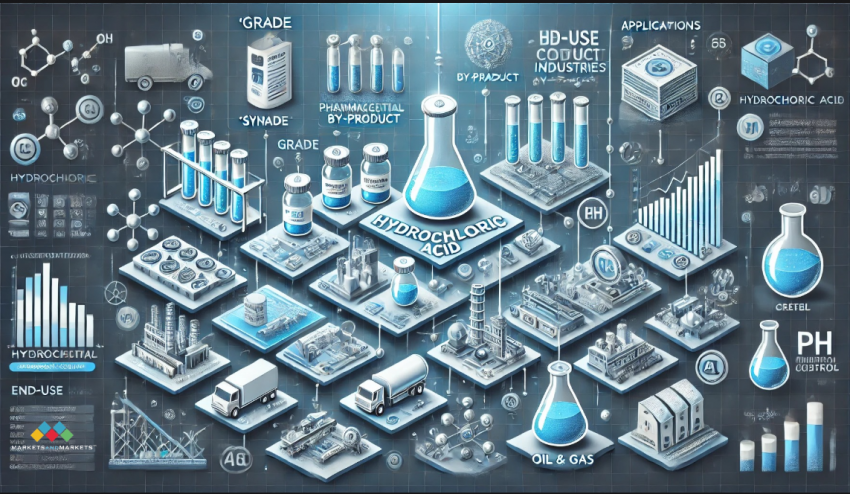Hydrochloric acid (HCl) may not be a household name for many, but it’s a vital industrial chemical that quietly powers many sectors around the globe. From chemical manufacturing and water treatment to steel pickling and food processing, hydrochloric acid plays a foundational role in a wide array of processes. As industries grow and evolve, so does the demand for HCl, shaping a robust and dynamic hydrochloric acid market.
Take a deep dive into what’s fueling the hydrochloric acid market, how industries are leveraging its properties, and the challenges and opportunities that lie ahead.
Hydrochloric acid is a clear, highly corrosive solution of hydrogen chloride in water. It’s a strong acid with wide-ranging industrial applications. It’s commonly produced as a by-product in the manufacturing of organic compounds like vinyl chloride and fluorocarbons. Its affordability, reactivity, and solubility make it indispensable in several sectors.
The Hydrochloric Acid Market was valued at USD 2.2 billion in 2024 and is projected to reach USD 3.0 billion by 2029, growing at 6.5% cagr from 2024 to 2029.
Key Market Drivers
1. Rising Demand in the Chemical Industry
The chemical industry is the backbone of hydrochloric acid consumption. It’s widely used in the production of chlorides, fertilizers, dyes, and other chemicals. As demand for these end-products rises—particularly in fast-developing economies—the need for hydrochloric acid follows suit. It’s a critical ingredient in processes like pH control, neutralization, and catalysis.
2. Growth in Water and Wastewater Treatment
Water treatment facilities around the world rely on hydrochloric acid for regulating pH levels, cleaning membranes, and removing impurities. As urban populations grow and water pollution becomes a global concern, investments in wastewater treatment infrastructure are climbing—boosting demand for HCl.
3. Steel Industry Support
Steel pickling, a process used to remove rust and impurities from steel, relies heavily on hydrochloric acid. With steady growth in the construction and automotive industries, steel consumption is increasing—especially in countries like China, India, and Brazil. This translates into a growing need for hydrochloric acid to support production efficiency.
4. Pharmaceutical and Food Sectors
Hydrochloric acid is also used in pharmaceutical manufacturing for synthesizing active ingredients and pH adjustments. In the food industry, it plays a role in processing ingredients, such as in the production of corn syrup. The global rise in healthcare demand and food processing innovations further fuel this market.
Noteworthy Trends in the Hydrochloric Acid Market
– Shift Toward Regeneration Technologies
Steel manufacturers and chemical producers are turning toward hydrochloric acid regeneration systems to reduce waste and enhance sustainability. These systems recover and reuse HCl, reducing environmental impact and improving cost-efficiency.
– Focus on Safe Transportation and Storage
Due to the highly corrosive nature of HCl, there’s an increasing focus on advanced packaging and secure transport systems. Tanker safety, leak-proof containers, and corrosion-resistant storage tanks are becoming standard in modern operations.
– Sustainable Production Practices
Sustainability is a growing priority. Producers are under pressure to reduce emissions during HCl production. As regulations tighten, companies are adopting greener methods, such as closed-loop systems and emission scrubbing technologies.
Regional Market Insights
Asia-Pacific Leads the Pack
The Asia-Pacific region is the largest and fastest-growing market for hydrochloric acid, thanks to rapid industrialization and urban development. China and India are the key contributors, with massive infrastructure projects, expanding manufacturing sectors, and booming agriculture industries.
North America and Europe Stay Steady
North America and Europe maintain stable demand, driven by advanced water treatment systems, pharmaceutical production, and well-established chemical industries. However, strict environmental regulations and high production costs slightly temper market expansion in these regions.
Challenges in the Market
While the hydrochloric acid market has strong growth potential, it’s not without hurdles:
- Environmental Regulations: Stringent regulations on acid emissions and disposal practices increase operational costs for producers.
- Raw Material Volatility: Prices of raw materials, especially chlorine and hydrogen, can fluctuate, affecting the stability of supply chains.
- Handling and Safety Concerns: Due to its corrosive nature, special precautions must be taken in storage, transport, and usage, adding complexity and cost.
Leading Players in the Hydrochloric Acid Market
Several global players dominate the hydrochloric acid space, offering high-quality products and expanding their reach through partnerships, mergers, and capacity enhancements. Some of the notable names include:
- Olin Corporation
- BASF SE
- Occidental Petroleum Corporation
- Ercros S.A.
- Covestro AG
These companies are investing in technology and regional expansion to cater to growing industrial demand and evolving regulatory landscapes.
Stay ahead with the latest trends – Download the PDF brochure.
Future Outlook
The hydrochloric acid market is set to grow steadily over the next decade. With expanding applications across construction, water treatment, chemicals, and healthcare, the need for reliable and efficient HCl solutions is rising. Industry innovation, coupled with a growing push for sustainable production, will define the next phase of this market’s evolution.

